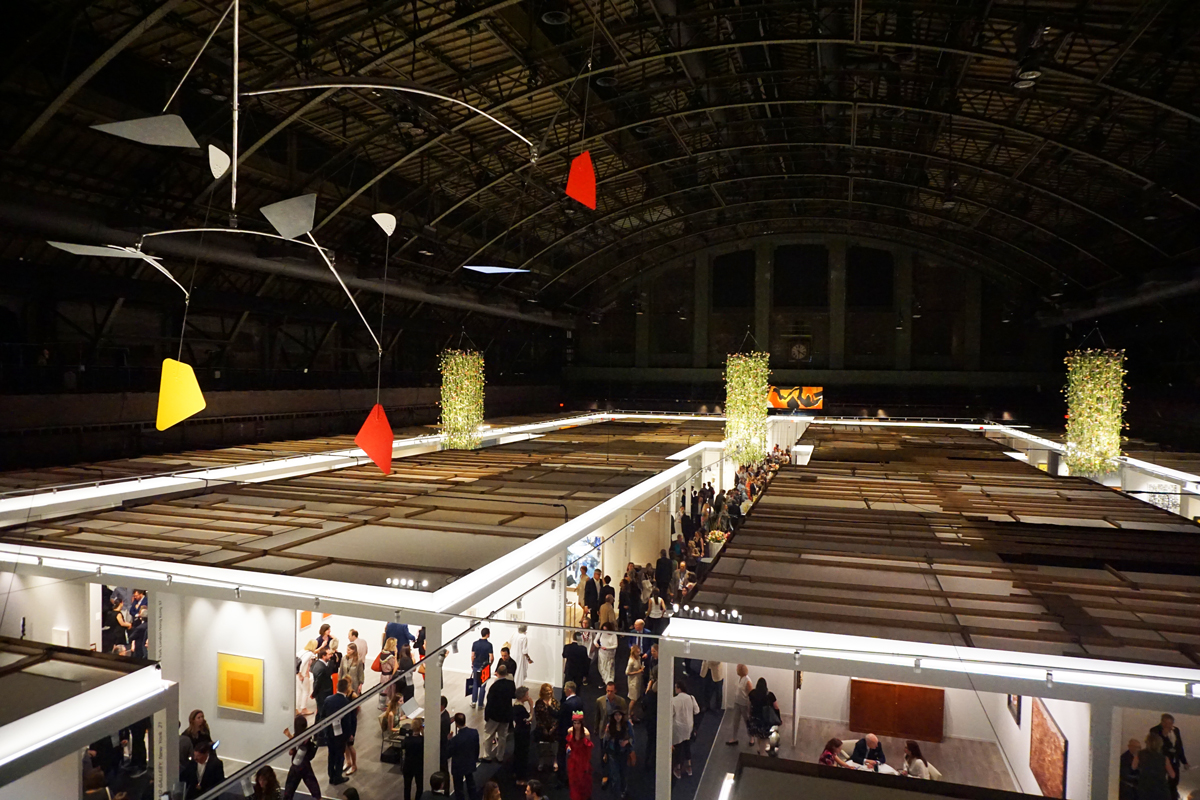[ad_1]
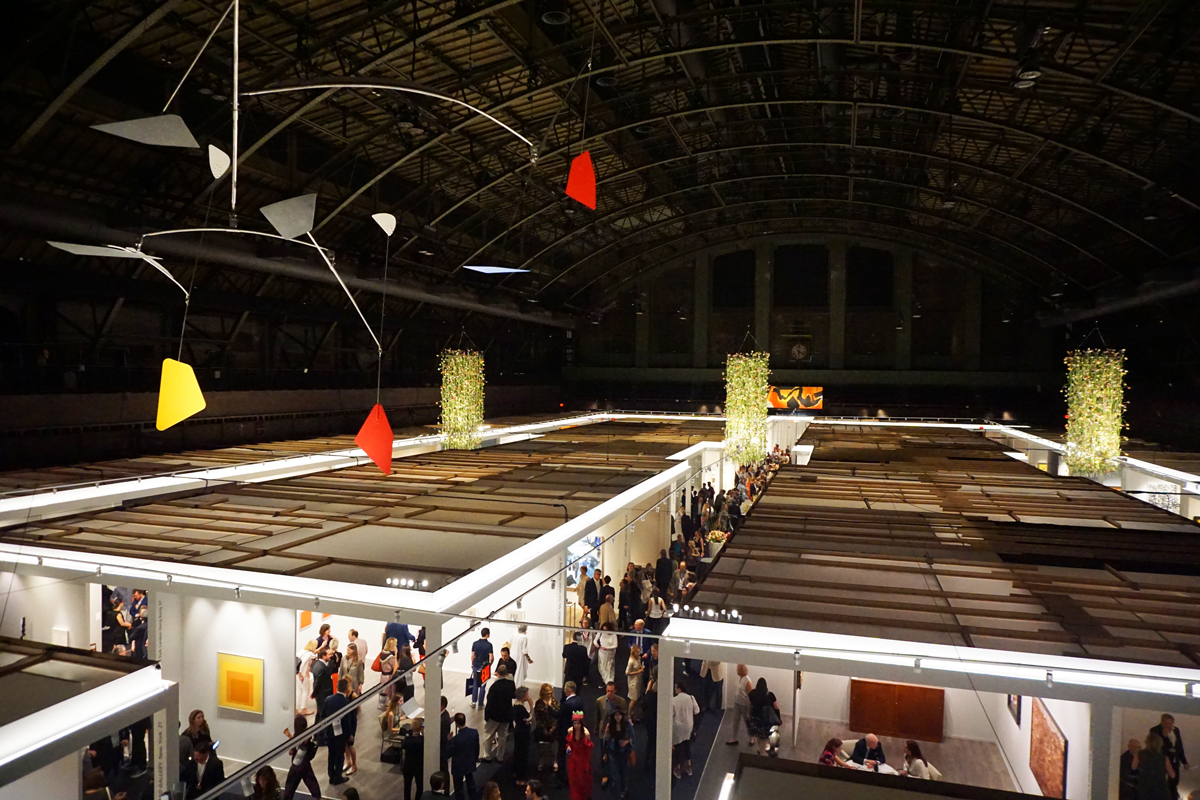
A 1970 Calder, Les Trois Barres, brought by New York dealer gallery Van de Weghe, looms over the 2018 edition of TEFAF Spring in New York, at the Park Avenue Armory.
MAXIMILÍANO DURÓN/ARTNEWS
Right at noon today, well-heeled collectors dressed in muted tones began to make their way into the Park Avenue Armory on Manhattan’s Upper East Side for the opening of the second edition of TEFAF Spring, and by just 1 p.m. the fair’s aisles were jam-packed with people sipping Champagne and shooting freshly shucked oysters as gigantic cylinders of flowers hung from the ceiling above them. The scene was quite a bit different from the one at Frieze New York yesterday, not least because, in keeping with the high-end spirit of the original TEFAF, which runs every March in Maastricht, the Netherlands, the roughly 90 dealers brought out deeply blue-chip art.
At Nahmad, whose booth right next to the entrance, a figurative wire sculpture by Calder, Hercules and Lion (1928), is not for sale, but its other works are priced from seven figures on up: a Jean Arp at $1.5 million, a Max Ernst at $12 million, a Fernand Léger at $13 million, and a Joan Miró at $15 million.
A not-insignificant number of galleries are doing both TEFAF and Frieze, like David Zwirner, and different strategies are on display at the two fairs. At Frieze, Zwirner had offered up the youngish guns Jordan Wolfson and Josh Smith; for TEFAF it had gone with modern masters, Josef Albers (two works by the artist sold by late afternoon, for $1.75 million $750,000) and Giorgio Morandi, with two works also selling, for undisclosed prices.
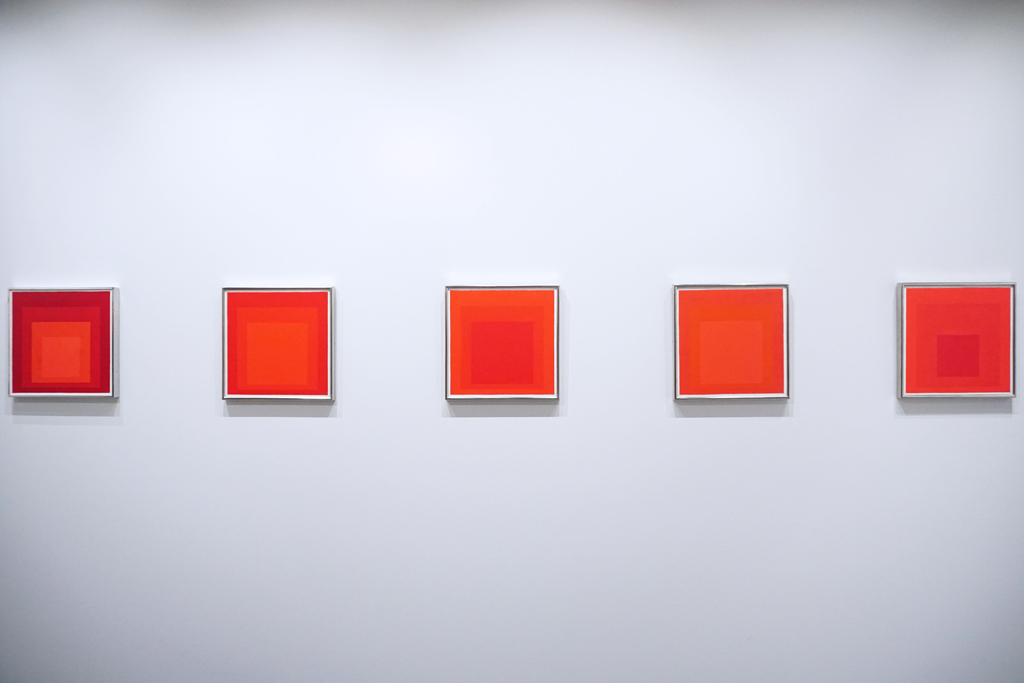
A suite of works by Josef Albers, on offer at David Zwirner, two of which have sold, at the 2018 edition of TEFAF Spring in New York, at the Park Avenue Armory.
MAXIMILÍANO DURÓN/ARTNEWS
“At TEFAF, all the work has to represent the best work of that artist,” a White Cube rep put it to me. “Nothing against Frieze, but here, we don’t show emerging artists. Even our lower-cost pieces are from a different period of contemporary art.” Pieces by Lee Seung-taek, Georg Baselitz, and David Hammons were on offer at the gallery, which just opened a gallery in New York last week and recently hired as a director the veteran deal John Good, an alumnus of Gagosian and Christie’s.
Not far away, Hauser & Wirth—another dual exhibitor—was presenting pieces by Eva Hesse, Philip Guston, and Louise Bourgeois, and early in the day it had already parted with a late Guston—painted in 1979, the year before his death—for $5.5 million.
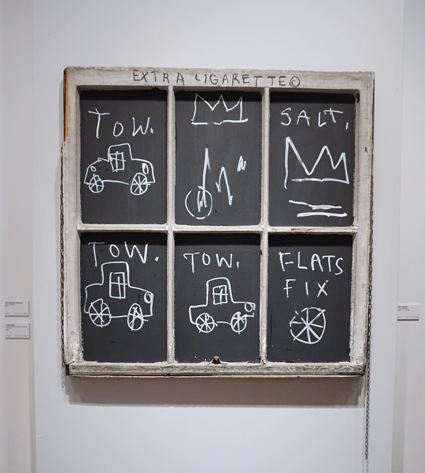
Jean-Michel Basquiat’s Extra Cigarette, 1982, in the booth of Lévy Gorvy, of New York, London, and Shanghai, at the 2018 edition of TEFAF Spring in New York, at the Park Avenue Armory.
MAXIMILÍANO DURÓN/ARTNEWS
Lévy Gorvy—which last night opened a Dan Colen show at its gallery, just a 10-minute walk from the Armory—sold a Warhol Brillo box for which it said it had been asking around $1 million and a 1982 Basquiat, Extra Cigarette, which had carried a price tag somewhere under $5 million. Also selling: an extremely early, extremely intricate red, orange, and yellow Yayoi Kusama watercolor from 1953 that it had valued at $950,000.
But while TEFAF Spring is focused on 20th- and 21st-century art, it is by no means limited to that category. At Phoenix Ancient Art, one can score a stunning gilded bronze Roman head of a “victorious ruler” from sometime around the 1st century B.C. to 1st century A.D. for about $4.8 million, or an alabaster head from the Middle East from the same period for $65,000. Stockholm-based fine-furnishing gallery Modernist sold a side table designed by Josef Frank for $32,000 and a 1925 lamp for $45,000 in the first hour of the fair. At Charles Ede, a marble head from 2nd-century B.C. Greece was priced at $230,000.
And Wildenstein & Co., the Paris-based Impressionist heavyweight, was on hand, doing its first-ever fair in New York just blocks from the East 64th Street townhouse it once called home. (It sold last year to a buyer believed to be from China for $79.5 million, and was promptly resold for $90 million in February.) Wildenstein has outfitted its booth with a bevy of Pierre Bonnard works that range from an exquisite little drawing of a woman for $50,000 to a long panoramic landscape that has its own wall and a price of $18 million.
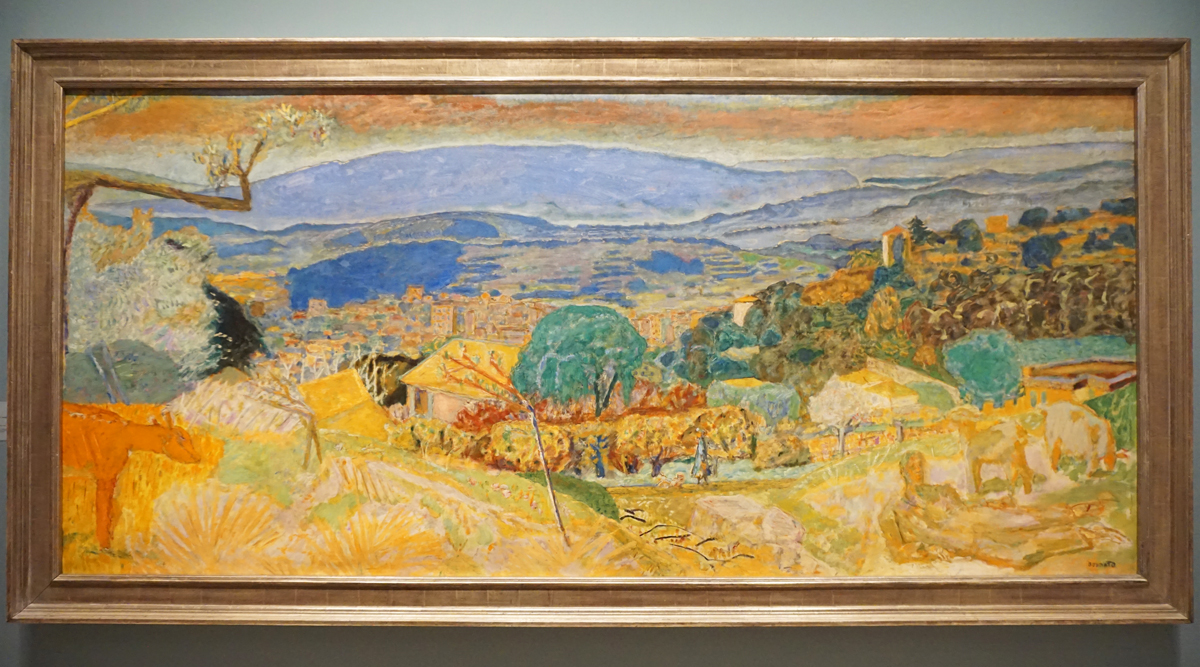
A Pierre Bonnard landscape, on offer for $18 million, at Paris’s Wildenstein & Co., at the 2018 edition of TEFAF Spring in New York, at the Park Avenue Armory.
MAXIMILÍANO DURÓN/ARTNEWS
Howard Shaw, of Hammer Galleries, which is toasting its 90th anniversary this year, said, “In a fair that is mostly modern, postwar, and contemporary, we brought a booth of major Impressionist paintings,” pointing to works by Degas, Renoir, and Pissarro, plus a Delacroix. Though he declined to discuss exact prices, he put the value of the booth at $50 million and said that a stunning portrait of Renoir’s muse Gabrielle Renard was on offer for less than the estimate of another Renard portrait that is being sold this week at Christie’s from the Rockefeller Collection. (That one is estimated at $7 million to $10 million.) Underbidders, or anticipated underbidders, take note!
The forthcoming Rockefeller sales are looming large this week and perhaps influencing what is on offer at TEFAF. One of the highlights coming up at Christie’s is a Rose period Picasso that is said to have an estimate around $100 million, and Picassos were also available en masse at TEFAF. Hammer Galleries had his work, as did the Seoul-based gallery Gana Art, which had priced a 1944 portrait at $19 million, and London and New York enterprise Dickinson has a 1963 portrait pegged at $12 million.
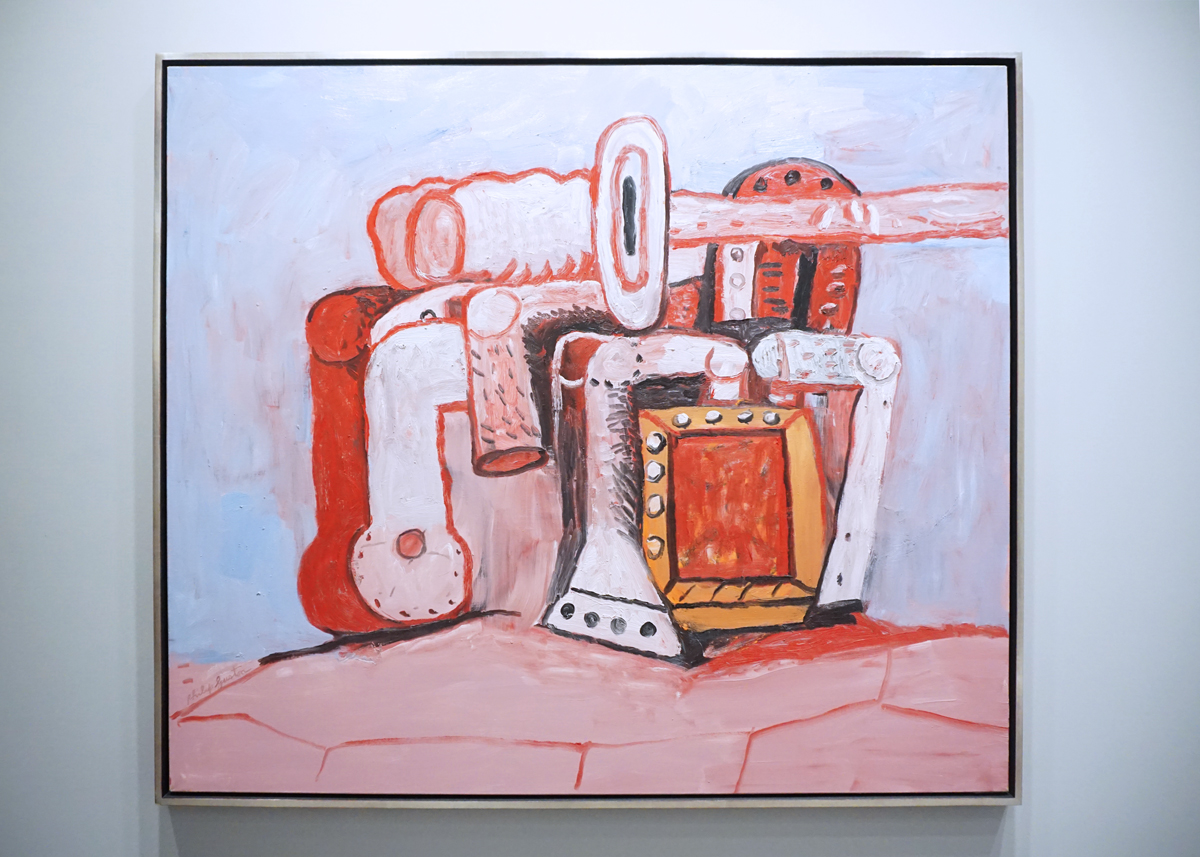
Philip Guston’s Forms on Rock Ledge, 1979, in the booth of Hauser & Wirth, at the 2018 edition of TEFAF Spring in New York, at the Park Avenue Armory.
MAXIMILÍANO DURÓN/ARTNEWS
Perhaps relieved to be in ample air-conditioning—a marked contrast from yesterday’s climate at Frieze—many seemed to be in a buoyant mood. Collector Johnny Pigozzi was in Gagosian’s booth, snapping photographs of all the action, as Larry Gagosian shook hands and Brice Marden greeted those coming by to see his joint display with John Currin. Eli Broad was wandering the booths, as well as former Hauser partner Paul Schimmel and assorted curators and museum directors.
At Emmanuel Perrotin’s TEFAF booth, its namesake dealer accepted a playful gibe from Norman Kleeblatt, the retired chief curator of the Jewish Museum in New York: “Much more clean and organized today, Emmanuel!” The dealer smirked back and replied, “Well, that was Frieze and this is TEFAF.” His sleek booth featured two works by Hans Hartung and a huge all-black number by Pierre Soulages.
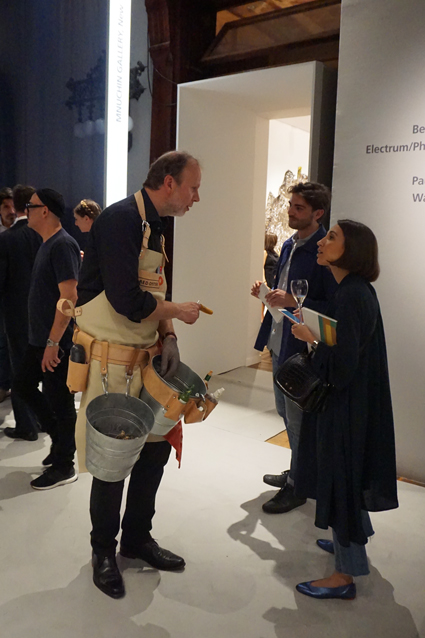
A roving oyster shucker makes conversation with guests at the VIP preview of the 2018 edition of TEFAF Spring in New York, at the Park Avenue Armory.
MAXIMILÍANO DURÓN/ARTNEWS
Such striking displays are par for the course at TEFAF. Richard Gray, of Chicago and New York, was presenting three sprawling Sam Francis works, and Gisela Capitain, of Cologne, had devoted a good chunk of its booth to two works by Martin Kippenberger—a painting and one of his discombobulated lamp sculptures.
The Swiss gallery Galerie Gmurzynska had hired creative director Robin Scott-Lawson to design its booth, and he responded with a look that resembled a sumptuous Space Age brutalist lounge, with gray walls and a circular sofa sunken into floor—all the better to display its works by Tom Wesselmann, Yves Klein, and Léger.
Standing outside the booth, Mathias Rastorfer, a partner in the gallery, praised TEFAF. “I like the concept, I like what it promises. I think it’s a very very good venue for modern galleries,” he said. “It’s a very good thing in New York to have—the quality, in what’s shown, in the location.” Just then Marc Spiegler, Art Basel’s head honcho, bounded out of the booth, joking that it looked like it had been cheap to build.
It had taken about a month to conceive, Krystyna Gmurzynska and her daughter Isabelle Bscher, said, and around four days to complete it. It will exist for just a total of six days. TEFAF opens to the public tomorrow, Friday, May 4, and closes on Tuesday.
Sarah Douglas and Andrew Russeth contributed reporting.
[ad_2]
Source link

